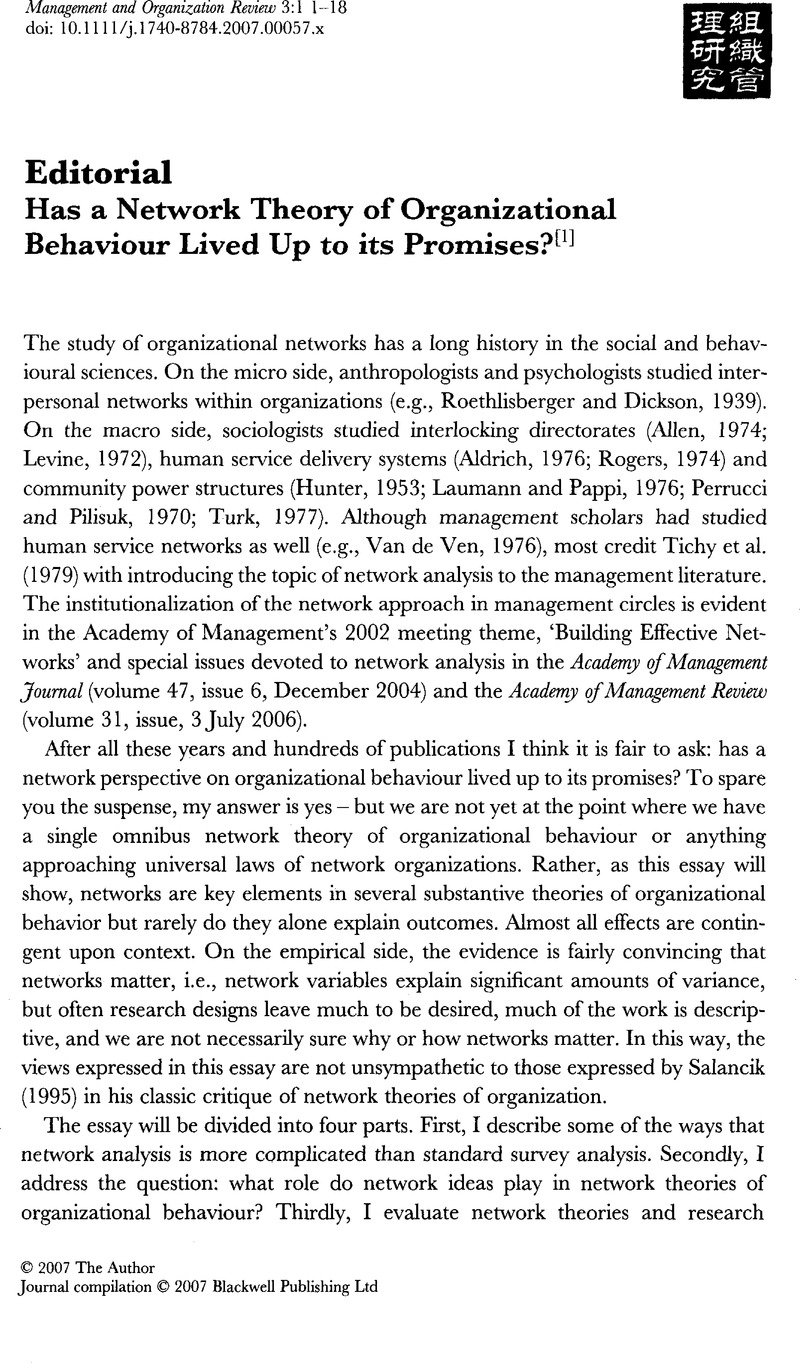Crossref Citations
This article has been cited by the following publications. This list is generated based on data provided by
Crossref.
Provan, Keith G.
Fish, Amy
and
Sydow, Joerg
2007.
Interorganizational Networks at the Network Level: A Review of the Empirical Literature on Whole Networks.
Journal of Management,
Vol. 33,
Issue. 3,
p.
479.
Lin, Zhiang (John)
Kitts, James A.
Yang, Haibin
and
Harrison, J. Richard
2008.
Elucidating strategic network dynamics through computational modeling.
Computational and Mathematical Organization Theory,
Vol. 14,
Issue. 3,
p.
175.
Kaše, Robert
Paauwe, Jaap
and
Zupan, Nada
2009.
HR practices, interpersonal relations, and intrafirm knowledge transfer in knowledge‐intensive firms: a social network perspective.
Human Resource Management,
Vol. 48,
Issue. 4,
p.
615.
Raab, Jörg
and
Kenis, Patrick
2009.
Heading Toward a Society of Networks.
Journal of Management Inquiry,
Vol. 18,
Issue. 3,
p.
198.
Chen, Ying
Friedman, Ray
Yu, Enhai
Fang, Weihua
and
Lu, Xinping
2009.
Supervisor–Subordinate Guanxi: Developing a Three-Dimensional Model and Scale.
Management and Organization Review,
Vol. 5,
Issue. 3,
p.
375.
Kastelle, Tim
and
Steen, John
2010.
Are small world networks always best for innovation?.
Innovation,
Vol. 12,
Issue. 1,
p.
75.
Chai, Sun-Ki
and
Rhee, Mooweon
2010.
Confucian Capitalism and the Paradox of Closure and Structural Holes in East Asian Firms.
Management and Organization Review,
Vol. 6,
Issue. 1,
p.
5.
Kilduff, Martin
and
Brass, Daniel J.
2010.
Organizational Social Network Research:Core Ideas and Key Debates.
Academy of Management Annals,
Vol. 4,
Issue. 1,
p.
317.
Milaković, Mishael
Alfarano, Simone
and
Lux, Thomas
2010.
The small core of the German corporate board network.
Computational and Mathematical Organization Theory,
Vol. 16,
Issue. 2,
p.
201.
Kilduff, Martin
and
Brass, Daniel J.
2010.
Organizational Social Network Research:Core Ideas and Key Debates.
Academy of Management Annals,
Vol. 4,
Issue. 1,
p.
317.
Tang, Shui Yan
and
Mazmanian, Daniel A.
2010.
Understanding Collaborative Governance from the Structural Choice - Politics, IAD, and Transaction Cost Perspectives.
SSRN Electronic Journal,
Whitbred, Robert
Fonti, Fabio
Steglich, Christian
and
Contractor, Noshir
2011.
From Microactions to Macrostructure and Back: A Structurational Approach to the Evolution of Organizational Networks.
Human Communication Research,
Vol. 37,
Issue. 3,
p.
404.
최재성
이수연
안은영
박소정
Jun Young Lee
and
김신열
2011.
Whole Network Effectiveness from Multiple Stakeholders Perspectives - A Case of Community Networking Enhancement Project -.
Korean Journal of Social Welfare,
Vol. 63,
Issue. 1,
p.
57.
GALASKIEWICZ, JOSEPH
2011.
STUDYING SUPPLY CHAINS FROM A SOCIAL NETWORK PERSPECTIVE.
Journal of Supply Chain Management,
Vol. 47,
Issue. 1,
p.
4.
Hom, Peter W.
and
Xiao, Zhixing
2011.
Embedding social networks: How guanxi ties reinforce Chinese employees’ retention.
Organizational Behavior and Human Decision Processes,
Vol. 116,
Issue. 2,
p.
188.
Whelan, Chad
2011.
Network Dynamics and Network Effectiveness: A Methodological Framework for Public Sector Networks in the Field of National Security.
Australian Journal of Public Administration,
Vol. 70,
Issue. 3,
p.
275.
Ceci, Federica
and
Iubatti, Daniela
2012.
Personal relationships and innovation diffusion in SME networks: A content analysis approach.
Research Policy,
Vol. 41,
Issue. 3,
p.
565.
Clarke, Ruth
and
Charles, Reccia N
2012.
Caribbean liming.
International Journal of Cross Cultural Management,
Vol. 12,
Issue. 3,
p.
299.
Kaše, Robert
King, Zella
and
Minbaeva, Dana
2013.
Using Social Network Research in HRM: Scratching the Surface of a Fundamental Basis of HRM.
Human Resource Management,
Vol. 52,
Issue. 4,
p.
473.
Moslehi, Adel
Linger, Henry
and
Tanner, Kerry
2014.
Diversity of knowledge in patent co-authorship networks – case studies in the Victorian biotechnology industry.
VINE,
Vol. 44,
Issue. 4,
p.
496.
